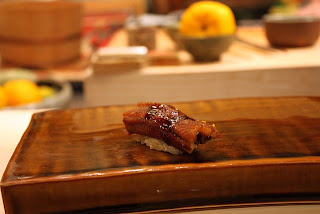Sushi Ota from all aspects (along with online reviews) is the best available sushi restaurant in San Diego. Even though I recently had experience sushi nirvana at Urasawa, my brave friend still added Sushi Ota on our food agenda for that day. Yes, brave would be the word since I did not plan on eating sushi for 3-4 months after Urasawa. Since we just munched on some carne asada fries, pollo asada burrito, and rolled tacos earlier at Super Sergios, we were just going for a "light" snack at Ota.

Kumamoto Oysters (w/ponzu sauce, grated daikon, and scallions)

Kumamoto Oysters (w/ponzu sauce, grated daikon, and scallions)
Being a fan of raw oysters, especially the Kumamoto oysters, this was a must order. The kumamoto oysters, native of Ariake Bay in Kumamoto Prefecture, on the southern island of Kyushu were fresh and delicious. The ponzu sauce added a nice touch to the dish, along with the grated daikon and scallions. This dish actually exceeded my expectations, and I was ready for the upcoming sashimi and sushi orders.
 Closeup of the Hamachi
Closeup of the Hamachi
 Closeup of the Hamachi
Closeup of the HamachiWhat else is better to test out the freshness of the fish used at a sushi restaurant than trying out their sashimi? We went with the hamachi (one of my favorites) and sake combo. The hamachi sashimi was fantastic, one of the better versions I've had. The fish was buttery, fatty, and the richness was enhanced with a slight dab of wasabi and shoyu. Although the salmon is a fairly common cut of fish at any sushi restaurant, the cuts served here also impressed. Both the hamachi and salmon pieces were great. Not much more to add other than fresh cuts of fishes will always get thumbs up from me!
 Ankimo (Monk Fish Liver)
Ankimo (Monk Fish Liver)
 Ankimo (Monk Fish Liver)
Ankimo (Monk Fish Liver)Ankimo, another one of my personal favorites, but, it's also something that I'm a bit more stringent in grading. The steamed monk fish liver pieces were served in ponzu sauce, with grated scallions daikon, similar to how the kumamoto oysters were served. To me, and to many others, ankimo is the Japanese foie gras, but just not as rich as the authentic item. I enjoyed the ankimo offered at Ota, and like with many I've had previously, the ponzu sauce was an important complement to the dish.
 Spider Rolls (Foreground), Ebi Sushi (background)
Spider Rolls (Foreground), Ebi Sushi (background)
 Spider Rolls (Foreground), Ebi Sushi (background)
Spider Rolls (Foreground), Ebi Sushi (background)I don't have too much to comment with these 2 items. I didn't try the ebi (shrimp) sushi, as I've never been interested with it, and the spider roll was fairly pedestrian, but enjoyable. Wrapped in tofu skin, it contains nori, rice, fried soft shelled crab, avocado, cucumbers, and imitation crab meat. This wasn't the hightlight of the meal, but it wasn't too shabby either.
 Another shot of the amaebi
Another shot of the amaebi
 Another shot of the amaebi
Another shot of the amaebiOne of the reasons I don't care too much for the ebi is due to my love of the amaebi. My take is, why eat the ebi (shrimp), if I could have something better in the amaebi (sweet shrimp). The presentation and the freshness (I'm using this word too damn much!) of the amaebi impressed me. The shrimp was so fresh that its antennas were still moving during the time the plate was in front of us. Along with the antennas, the eye(s) of one particular shrimp was also moving. Eating these shrimp reminded me of eating some freshly cut up octopus back in Japan that were moving continuously on the plate, which didn't stop even as it was going down my throat. The amaebi was the highlight of our meal and I enjoyed every aspect of it, including the fried shrimp head (as shown below):
 Fried Amaebi Heads
Fried Amaebi Heads
 Fried Amaebi Heads
Fried Amaebi HeadsAll in all, I was quite pleased with Sushi Ota. I was fairly skeptical at first, especially seeing most of the clientele were *ahem* non-Asian, gwai-lo/bai ren. Most of the time, that would have sent up red flags in my brain, especially us experiencing the worst boba we've ever had in our lives earlier in the day made by a *ahem* non-Asian, a hak gwai/hei ren. Even after eating at Urasawa the week before, I can still confidently say, although the price isn't cheap, Sushi Ota serves some pretty decent cuts of fish. I recommend this place if you're down in the area looking for some good sushi.
*Note* Thanks again to my special friends that took me down to San Diego for the day. Yes, I will forgive you for taking me to that horrible boba place on Convoy :)
Final Grade
4529 Mission Bay Drive
San Diego, CA 92109
(858) 270-5670
*Note* Thanks again to my special friends that took me down to San Diego for the day. Yes, I will forgive you for taking me to that horrible boba place on Convoy :)
Final Grade
- Taste: 4 out of 5
- Decor: 3.5 out of 5
- Service: 3.5 out of 5
4529 Mission Bay Drive
San Diego, CA 92109
(858) 270-5670






































































